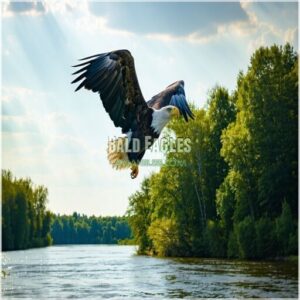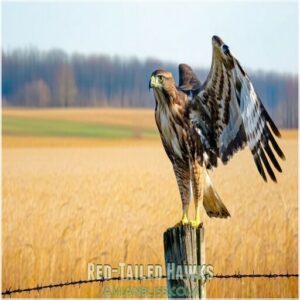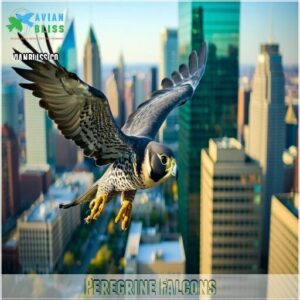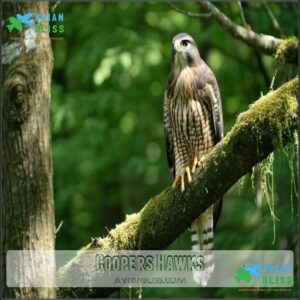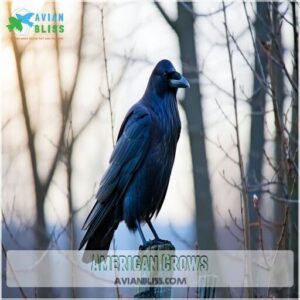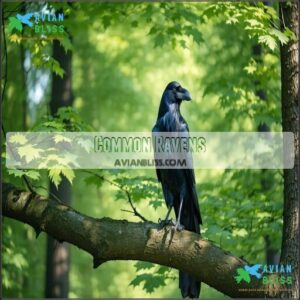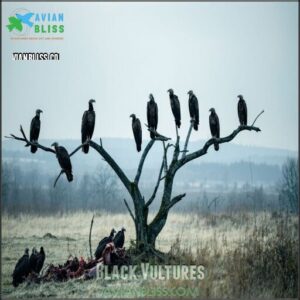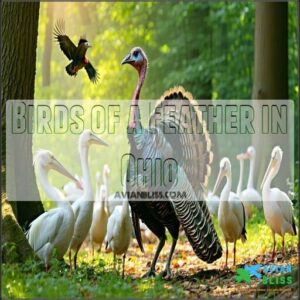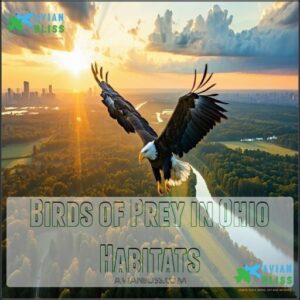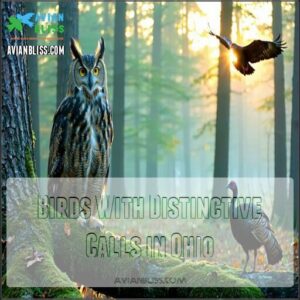This site is supported by our readers. We may earn a commission, at no cost to you, if you purchase through links.
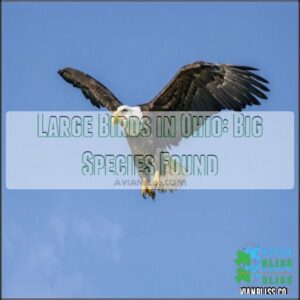 You’ll spot some amazing large birds in Ohio, like bald eagles, red-tailed hawks, and great blue herons.
You’ll spot some amazing large birds in Ohio, like bald eagles, red-tailed hawks, and great blue herons.
These birds thrive in Ohio’s diverse habitats, from forests to wetlands.
As you explore the state, you’ll have plenty of chances to see these incredible creatures up close.
With over 400 species of birds calling Ohio home, you’re in for a treat, and you might just find your new favorite feathered friend, with many more surprises waiting to be uncovered, in the fascinating world of large birds in Ohio.
Table Of Contents
- Key Takeaways
- Large Birds of Prey in Ohio
- Big Black Birds in Ohio
- Birds With Long Legs in Ohio
- Birds With Red Heads in Ohio
- Geese and Swans in Ohio
- Birds of a Feather in Ohio
- Birds of Prey in Ohio Habitats
- Large Waterbirds in Ohio
- Birds With Distinctive Calls in Ohio
- Rare and Endangered Large Birds in Ohio
- Frequently Asked Questions (FAQs)
- What is the largest bird in Ohio?
- Which birds have been spotted in Ohio?
- What small birds can you spot in Ohio?
- Where can you watch birds in Ohio?
- What are the big birds in Ohio?
- What are the large gray and white birds in Ohio?
- What is the largest raptor in Ohio?
- How do you tell if a bird is a hawk or a falcon?
- What are the biggest birds in size?
- What is the largest black bird in Ohio?
- Conclusion
Key Takeaways
- You’ll spot some amazing large birds in Ohio, like eagles, hawks, and herons, that thrive in the state’s diverse habitats, from forests to wetlands, and you can explore these habitats to learn more about them.
- As you explore Ohio, you’ll have plenty of chances to see these incredible creatures up close, including birds of prey like Bald Eagles and Red-tailed Hawks, and you can use tools like binoculars to get a better look.
- You’ll discover that Ohio is home to over 400 species of birds, including large waterbirds like Great Blue Herons and Trumpeter Swans, and you can visit state parks and nature reserves to see them in their natural habitats.
- You can make a difference for rare Ohio birds by supporting conservation efforts, protecting habitats, and raising awareness about endangered species, and you can start by learning more about the largest bird in Ohio, the Trumpeter Swan, and how you can help protect it.
Large Birds of Prey in Ohio
You’re about to explore the amazing world of large birds of prey in Ohio, where you’ll find species like Bald Eagles and Red-tailed Hawks.
Discover Ohio’s majestic birds of prey, including Bald Eagles and Red-tailed Hawks, in their natural habitats.
As you read on, you’ll learn more about these incredible birds, their habitats, and what makes them so unique in the Buckeye State.
Bald Eagles
You’ll spot Bald Eagles, with their 6-7 foot wingspans, near Ohio’s rivers and wetlands.
They primarily catch fish and scavenge carrion as part of their Eagle Diet.
With over 900 Nesting Sites, Ohio’s population thrives, thanks to Conservation Status efforts and Eagle Rehabilitation programs, making them a notable large Ohio bird species and iconic birds of prey in Ohio.
Enthusiasts can find eagle watching gear to enhance their viewing experience.
Red-Tailed Hawks
You’re likely familiar with bald eagles, but Red-tailed Hawks rule Ohio’s skies.
They’re adaptable, with 4-foot wingspans, and rusty-red tails.
Here are some key facts:
- Sturdy nest builders
- Patient hunters
- Variable migrators
They thrive in diverse landscapes, showcasing their impressive adaptability. Some people even use a hawk decoy product to deter other birds.
Great Horned Owls
You’re now exploring Great Horned Owls, Ohio’s nocturnal hunters.
These birds of prey thrive in various habitats, including:
- Dense forests for roosting
- Open fields for hunting
- Abandoned nests for nurseries
- Suburban areas for rodent populations.
Their silent flight and haunting hoots make them a unique species.
As a bird watcher in Ohio, you can spot Great Horned Owls year-round, showcasing their habitat adaptability and diverse diet, a true marvel of Ohio’s birds of prey and raptors.
Peregrine Falcons
You’ll marvel at Peregrine Falcons’ diving speed, up to 200 mph, as they dominate Ohio’s daytime skies.
These birds of prey thrive in urban nesting sites, using aerial hunting to catch prey mid-flight.
A conservation success, they’ve recovered from near extinction, making them a thrilling sight for Ohio bird watching enthusiasts, showcasing their impressive skills as raptors in Ohio, with a notable diving speed.
Coopers Hawks
After marveling at the Peregrine Falcon’s speed, let’s look at another impressive raptor. The Cooper’s Hawk, a medium-sized bird of prey, is an agile hunter you might spot in Ohio’s woodlands.
These hawks in Ohio have slate-gray backs and rusty barred chests. Look for their rounded tails!
As songbird predators, they use stealth. During hawk migration, they’re easier to see.
Here’s what makes them special:
- Hawk diet: mostly songbirds ambushed mid-air.
- Bird nests: 25-50 feet high in trees.
- Feather care: guarantees silent flight.
- Nest reuse: they return to successful sites.
For identification tips, remember urban hawks often exhibit nest reuse. If you’re into Ohio bird watching, keep an eye out for this raptor in Ohio!
Big Black Birds in Ohio
You’re likely familiar with some of Ohio’s big black birds, like American Crows and Common Ravens.
As you explore the state, you’ll also spot other large black birds, including Barred Owls and Black Vultures, each with unique characteristics and habits.
American Crows
Spotting American Crows in Ohio is easy, given their intelligence and adaptability. You’ll find them everywhere, using tools and solving problems.
- They thrive in various habitats
- Their diet includes insects and roadkill
- Crow intelligence is notable
- They make over 20 vocalizations.
As a member of corvids, American Crows are common Ohio birds, displaying complex Crow behavior and social structures, making them fascinating to learn about.
Common Ravens
You’re into Common Ravens, one of Ohio’s large birds.
They prefer forests and cliffs for nesting, showcasing their intelligence.
| Raven Sightings | Raven Intelligence | Raven Folklore |
|---|---|---|
| Increasing | Problem-solving | Mysterious |
| Rare | Tool use | Intelligent |
| Local | Adaptive | Social |
| Seasonal | Complex | Fascinating |
They demonstrate remarkable abilities, making them a fascinating Ohio bird to watch, with conservation efforts focusing on their habitats.
Barred Owls
You’re likely wondering what rules the night in Ohio’s forests.
Barred Owls take center stage with their:
- Distinctive calls
- Striped plumage
- Nocturnal behavior, thriving in Ohio’s mature woodlands, with a diet consisting of small animals, their conservation status is a concern, making Ohio birdwatching efforts essential for these large Ohio birds, specifically owls in Ohio, like the Barred Owl.
Their conservation status is a concern, making Ohio birdwatching efforts essential for these large Ohio birds.
Black Vultures
You’re now exploring Black Vultures, birds of prey in Ohio.
They’re monogamous, with a carrion diet.
- Feed on dead animals
- Follow Turkey Vultures
- Have a broad vulture range
Black Vultures thrive in open country, providing ecosystem services as nature’s cleanup crew, consuming carrion, and are among large Ohio birds, serving as nature’s cleanup crew.
Birds With Long Legs in Ohio
You’re likely to spot birds with long legs in Ohio’s wetlands and grasslands, where they forage for food.
As you explore the state, you’ll see species like Great Blue Herons, Snowy Egrets, and Sandhill Cranes, with their distinctive long legs, roaming around.
Great Blue Herons
You’ll find Great Blue Herons in Ohio’s wetlands, with a 6-foot wingspan, hunting fish and frogs.
| Heron Diet | Nesting Habits |
|---|---|
| Fish | Colonies |
| Frogs | Trees |
| Small mammals | Wetlands |
| Birds | Heronries |
Snowy Egrets
As you explore Ohio’s wetlands, you’ll spot Snowy Egrets, identified by:
- White feathers
- Black legs
- Yellow feet
- Small size
- Elegant hunting technique.
They prefer shallow waters, displaying fascinating behavior.
Their Snowy Egret ID is distinct, with a diet and hunting style that’s both unique and efficient, making them a joy to watch in Ohio’s bird habitats during Ohio bird watching season.
Great Egrets
You’re spotting Great Egrets in Ohio’s wetlands, admiring their white plumage.
They forage for fish, and as an Ohio Species of Concern, they nest in Lake Erie’s Western Basin, showcasing Egret behavior, habitat, and diet, making them a prized target for Ohio bird watching, with a focus on Egret conservation.
These birds display distinctive breeding plumage during mating season.
Sandhill Cranes
Sandhill Cranes move across Ohio. You’ll see these birds. They’ve red crowns and gray feathers. They stand 4.5 feet tall.
During Crane Migration, you can hear their calls.
Their mating rituals are cool!
- Jumping
- Flapping
- Synchronized moves
- Dancing
Sandhill Crane habitats are open. You’ll find them near wetlands.
Their Crane Diet includes plants and bugs. Conservation Efforts help them thrive. Habitat Loss is a threat.
These Large birds in Ohio are Ohio birds to watch in Ohio bird habitats during Ohio bird migration.
Birds With Red Heads in Ohio
You’re looking for birds with red heads in Ohio, and you’ll find some stunning species like Red-Headed Woodpeckers and Northern Cardinals.
These birds are pretty easy to spot, and with a little practice, you’ll be able to identify them by their bright red heads and distinctive songs.
Red-Headed Woodpeckers
You’ll love watching Red-headed Woodpeckers in Ohio’s open woodlands, where oak and hickory trees thrive.
Their crimson heads and black-and-white bodies make them a favorite among bird enthusiasts.
They’re cavity experts, with notable behaviors including:
- They’re cavity experts, nesting in dead trees and utility poles
- Store acorns and nuts for winter
- Practice "flycatching" to snare insects
- Create habitat in oak woodlots
- Face population decline due to habitat loss.
As you observe these large birds in Ohio, note their distinctive identifying features and diet variations, and consider conservation efforts to preserve their habitat, a vital step in protecting Ohio birds, especially Redheaded Woodpeckers, from habitat loss.
Red-Winged Blackbirds
You’ll notice Red-winged Blackbirds in Ohio’s wetlands, with males showcasing red-and-yellow shoulder patches.
They announce their territory with "conk-la-ree" calls, displaying territorial behavior.
Their diet variation and mating rituals are interesting, with nesting habits near water.
As Ohio birds, they exhibit unique migration patterns, making them a fascinating sight for Ohio bird watching enthusiasts.
Northern Cardinals
You’ll enjoy watching Northern Cardinals, with their brilliant crimson feathers.
- They inhabit Cardinal Habitats like woodlands and backyards
- Their Cardinal Diet consists of seeds and insects
- Listen for their unique Cardinal Song
- Admire their vibrant Cardinal Plumage, a key for bird identification Ohio.
As you explore Ohio bird watching, remember Cardinal Conservation is essential for these Ohio birds, making them a delight to see in Ohio wildlife, as noted in your Ohio bird guide.
Scarlet Tanagers
You’re spotting Ohio birds, now focus on Scarlet Tanagers.
They’ve scarlet plumage and black wings.
| Scarlet Tanager ID | Habitat Preferences | Breeding Behavior |
|---|---|---|
| Ruby plumage | Forests | Monogamous |
| Black wings | Woodlands | Territorial |
| Flutelike song | Wetlands | Migratory |
The table provides information on the Scarlet Tanager’s characteristics, including its plumage, habitat preferences, and breeding behavior.
Geese and Swans in Ohio
You’ll find several large waterfowl species in Ohio, including geese and swans, which are known for their distinctive calls and impressive size.
As you explore the state’s wetlands and parks, you’ll likely spot Canada Geese, Snow Geese, Tundra Swans, Trumpeter Swans, and Mute Swans, each with unique characteristics and habits.
Canada Geese
You’ll see many Canada Geese in Ohio, flying in V-shaped flocks during Goose Migration.
They thrive in various habitats, exhibiting unique Goose Behavior, and eating a diverse Goose Diet.
As a key part of Ohio birds and Large birds in Ohio, Canada Geese impact local ecosystems, making them a fascinating subject for Ohio bird watching.
Snow Geese
You’re witnessing a breathtaking spectacle as Snow Geese migrate through Ohio.
Here are key facts about them:
- Flocking behavior creates unforgettable sights.
- Migration patterns show impressive endurance.
- Conservation status is a challenge due to mixed population trends.
For Snow Goose ID, note their white and dark morphs.
Ohio sightings are a thrill for birdwatching, highlighting the state’s rich bird diversity, including geese and swans, with essential habitat needs during migration.
The conservation status and needs of these birds are crucial for their survival.
Tundra Swans
You’ll marvel at Tundra Swans, migrating thousands of miles to Ohio’s wintering grounds.
These large birds captivate with graceful behavior and loyalty, fueling epic journeys with aquatic plants, starring in wetland ecology.
They benefit from Swan Conservation efforts, a treasure for Ohio bird watching and wildlife enthusiasts.
Trumpeter Swans
You’re now exploring Trumpeter Swans, a true marvel of Ohio bird watching.
These majestic birds have made a comeback thanks to Swan Conservation efforts.
Here are a few interesting facts about them:
- They can weigh up to 25 pounds and have a 6-foot wingspan.
- They frequent peaceful wetlands, a key part of their Swan Habitat.
- Their Swan Diet consists mainly of aquatic plants and algae.
As you learn about Trumpeter Swans, you’ll appreciate their importance in Ohio wildlife and the success of Swan Reintroduction programs.
Mute Swans
You’ll spot Mute Swans gliding across Ohio’s waters, their white feathers shining. Originating from Europe, they’ve made ponds and lakes their home.
Don’t mistake their calm nature as timid – they hiss to warn intruders. Mute Swans thrive in wetlands, feeding on aquatic plants, and are fiercely protective of their young.
As an invasive bird species, their impact on Ohio wildlife is significant. For Ohio bird watching, identifying Mute Swans is key.
Their diet consists of aquatic plants, which can affect wetland health. Mute Swan Conservation efforts are essential to maintain the balance of Ohio’s ecosystem, ensuring the preservation of Ohio’s wildlife and the overall ecosystem balance.
Birds of a Feather in Ohio
You’re about to explore some amazing birds in Ohio, including Wild Turkeys, Pileated Woodpeckers, and American White Pelicans.
As you read on, you’ll learn more about these large birds and their unique characteristics, getting a closer look at the fascinating world of Ohio’s birdlife.
Wild Turkeys
You’re observing Wild Turkeys in Ohio.
They showcase interesting behaviors, like
- Turkey Behavior
- Mating Rituals
- Turkey Diet
- Conservation efforts.
These large birds forage for seeds and insects, with females creating simple nests on the forest floor, contributing to Ohio’s rich bird watching scene, including birds of prey and large species.
Highlighting Wild Turkey conservation and Ohio nature is crucial, as it plays a significant role in the state’s ecosystem.
Pileated Woodpeckers
You’re now looking at Pileated Woodpeckers, Ohio’s largest woodpeckers.
They thrive in mature forests with deadwood, feeding on carpenter ants and beetles.
Recognizable by their "kuk-kuk-kuk" calls and drumming, they play a pivotal role in forest ecosystems, creating cavities for other animals.
Their bold red crests make them iconic, with a diet composition focused on insects, showcasing their importance in Ohio bird habitats and Ohio bird watching.
American White Pelicans
You’ll marvel at American White Pelicans, one of Ohio’s largest birds, with their vast wingspans and cooperative flocking behavior.
They play a key role in Ohio bird watching, during Pelican Migration, showcasing their unique Pelican Diet and Habitat, contributing to Ohio’s bird diversity.
Double-Crested Cormorants
Explore the realm of the Double-crested Cormorant. These large birds in Ohio thrive in wetlands. You can spot them during Ohio bird watching.
- Cormorant Diet: Fish are their main meal.
- Nesting Habits: They love tree-filled islands.
- Plumage Changes: Their feathers change with age.
- Conservation Status: Ohio sightings are increasing.
Their unique diving skills make them masters of the water. You’ll find them nesting in colonies. These bird species are truly fascinating.
Birds of Prey in Ohio Habitats
You’re about to explore the amazing world of birds of prey in Ohio, where you’ll find hawks, eagles, and owls thriving in various habitats.
As you read on, you’ll discover how these large birds adapt to forests, grasslands, wetlands, and even urban areas, making Ohio a great place to spot them, with its unique blend of natural habitats.
Forests and Woodlands
You’re exploring Ohio’s forests and woodlands, where birds of prey thrive.
As a canopy hunter, the Great Horned Owl reigns, while the Barred Owl and Pileated Woodpecker also call this habitat home.
Forest nesting is key for these species, but habitat loss and seasonal changes impact their populations.
Consider providing nesting options to support local owl populations.
Ohio’s raptors, like the Great Horned Owl, face challenges, making conservation efforts essential.
Grasslands and Prairies
As you explore Ohio’s grasslands, you’ll find a haven for large birds.
Harrier hunting and Kestrel hovering are common sights.
Here are key features of these habitats:
- Abundant prey
- Unobstructed views
- Varied grass cover
- Space for aerial displays
- Plentiful nesting options.
Prairie restoration helps combat habitat loss, supporting birds of prey in Ohio, like eagles and vultures, making Ohio a great spot for birding.
Wetlands and Marshes
In Ohio’s wetlands and marshes, you’ll find birds of prey like the Great Blue Heron.
- Great blue herons
- Sandhill cranes
- Trumpeter swans
- American white pelicans, facing threats like habitat loss and poor water quality.
Urban and Suburban Areas
You’ll find several large birds in Ohio’s urban and suburban areas. Red-tailed hawks thrive on skyscrapers, hunting rodents with ease. Peregrine falcons make high-rise ledges their nesting locations, diving at breathtaking speeds for prey like pigeons.
Urban adaptations enable these birds to coexist with human interaction. Conservation efforts focus on preserving nesting locations and prey availability.
Birdwatching in Ohio’s cities reveals a unique side of nature, showcasing urban birds’ ability to thrive in human-dominated environments, making Ohio a great spot for observing large birds in their natural habitats. These raptors play an important role in the ecosystem, with urban adaptations and conservation efforts being critical for their survival, and their ability to thrive in these environments is notable.
Large Waterbirds in Ohio
Often, near Ohio’s lakes, you’ll spot large waterbirds. These aquatic birds thrive in unique waterbird habitats.
Let’s check some out!
- Great Blue Heron: You’ll see them along rivers. They’re patient fishers in Heron Habitats.
- Trumpeter Swan: These swans are sensitive during breeding. So, let’s respect their space!
- Tundra Swan: See them during Swan Migration. They’re among Ohio’s largest waterfowl.
- Canada Goose: You might see them. They’re everywhere!
Mute Swans have curved necks. Cormorants have a unique Cormorant Diet. Crane Conservation is important for Sandhill Cranes. Great Egrets have beautiful Egret Plumage.
Many of these birds follow well-defined migration patterns.
Birds With Distinctive Calls in Ohio
Listening to birds in Ohio is a treat. You’ll hear the Barred Owl’s iconic "Who cooks for you?" hoot, the Wild Turkey’s comical gobble, and the American Crow’s loud "caw-caw".
The state’s birds of prey, like the Great Horned Owl and Hawk, make distinctive cries. Even Vulture calls and Eagle screeches add to the symphony.
As you venture out, you’ll discover the unique vocalizations of Ohio’s raptors, including Falcon vocalizations. From Owl hoots to Hawk cries, each bird call is a treasure to hear.
Bird calls aid in species identification. So, take a moment to appreciate the melodies of Ohio’s birds, and you’ll feel a sense of freedom and connection to nature, which is a truly unique experience.
Rare and Endangered Large Birds in Ohio
You can make a difference for rare Ohio birds. Habitat loss and population decline threaten large birds in Ohio, like the Whooping Crane.
To help, consider these steps:
- Support conservation efforts with donations.
- Protect habitats by preserving wetlands and forests.
- Raise awareness about endangered species, like the Northern Goshawk.
Your actions can help rare birds thrive, ensuring a brighter future outlook for these magnificent creatures. By contributing to Ohio bird conservation, you’re giving large birds in Ohio a chance to survive, and that’s a pretty big deal for their legal protection. This is a significant step towards conservation efforts.
Frequently Asked Questions (FAQs)
What is the largest bird in Ohio?
You’ll spot the Trumpeter Swan as Ohio’s largest bird, with a wingspan almost 6 ft and weighing around 25 lbs, a truly majestic sight in the state’s skies.
Which birds have been spotted in Ohio?
You’ll discover a plethora of bird species, including eagles, hawks, owls, and waterfowl, that call Ohio home, offering a birdwatcher’s paradise with diverse habitats.
What small birds can you spot in Ohio?
You’ll see American Goldfinch, Blue Jay, and Cardinal, among others, with their vibrant colors and distinctive songs, in Ohio’s backyards and parks, a treat for bird enthusiasts and nature lovers.
Where can you watch birds in Ohio?
You can watch birds at Ohio’s state parks, nature reserves, and wildlife areas, offering ideal spots for birdwatching with diverse habitats and species.
What are the big birds in Ohio?
You’ll find eagles, hawks, and owls, like Bald Eagles and Red-tailed Hawks, thriving in Ohio’s diverse landscapes, a true marvel of nature’s grandeur, right in your backyard, literally.
What are the large gray and white birds in Ohio?
You’ll spot large gray and white birds like Great Egret, Great Blue Heron, and Osprey, with distinctive plumage, in Ohio’s wetlands and skies, a beautiful sight to behold always.
What is the largest raptor in Ohio?
You’ll discover the Bald Eagle is Ohio’s largest raptor, with a massive 71-91 inch wingspan and weighing 5-15 pounds, a truly impressive bird of prey.
How do you tell if a bird is a hawk or a falcon?
You can tell if a bird is a hawk or a falcon by its size, wing shape, and hunting style, with hawks being larger and falcons more agile and swift.
What are the biggest birds in size?
You’ll notice the largest birds are often waterfowl or raptors, like eagles, swans, or vultures, with impressive wingspans and weights, making them a sight to behold in their natural habitats.
What is the largest black bird in Ohio?
You’ll find the largest black bird in Ohio is the American Crow, or possibly the Common Grackle, both known for their sleek black plumage and distinctive calls.
Conclusion
Just like a bird taking flight, you’re now soaring with knowledge about large birds in Ohio.
You’ve discovered the diverse species, from eagles to herons, that call this state home.
As you explore, remember to keep an eye out for these amazing creatures, and who knows, you might just spot some incredible large birds in Ohio, making your adventure even more unforgettable with these large birds in Ohio.

